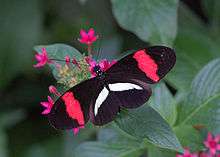Heliconius erato
| Red postman | |
|---|---|
| | |
| Heliconius erato petiverana | |
 | |
| Dorsal view | |
| Scientific classification | |
| Kingdom: | Animalia |
| Phylum: | Arthropoda |
| Class: | Insecta |
| Order: | Lepidoptera |
| Family: | Nymphalidae |
| Genus: | Heliconius |
| Species: | H. erato |
| Binomial name | |
| Heliconius erato (Linnaeus, 1758) | |
| Subspecies | |
|
many, see text | |
| Synonyms | |
| |
The red postman (Heliconius erato) is one of about 40 Neotropical species of butterfly belonging to the genus Heliconius. It is also commonly known as the small postman, the red passion flower butterfly, or the crimson-patched longwing.[1]
Description
The species is remarkably variable in colour and form throughout northern South America, depending on location, and its various appearances can be difficult to distinguish from various other Heliconius butterflies such as Heliconius sara, also known as the sara longwing. Particularly hard to distinguish is the related Heliconius melpomene, or "the postman", which mimics almost all the colour forms of Heliconius erato; colour forms are synchronized between the two throughout their common habitats. It is likely the clade containing Heliconius erato radiated first, establishing the wing pattern diversity found in both species of butterfly.[2] Two features found on the underside help to distinguish H. erato from H. melpomene—H. erato has four red dots where the wing attaches to the thorax while H. melpomene has three and the yellowish white stripe on the underside reaches the margin of the hindwing in H. erato but ends early in H. melpomene.[3]
Heliconius erato is up to about 5.5–8 cm (2.2–3.1 in)[4] in wingspan with a jerky unelegance in flight.
Like Heliconius charithonia, H. erato is one of the few butterflies that collects and digests pollen, conferring considerable longevity to the adults (several months). Adults roost in groups, returning to the same location each night.[5]
Recent Field work has confirmed the relative abundance of this butterfly.[6]
 Caterpillar
Caterpillar Female ovipositing
Female ovipositing
Origins
A recent study, using amplified fragment length polymorphism (AFLP) and mitochondrial DNA (mtDNA) data sets, places the origins of H. erato at 2.8 million years ago.[7] H. erato also shows clustering of AFLPs by geography revealing that H. erato originated in western South America.
Subspecies
Listed alphabetically.[1]
- H. e. adana Turner, 1967
- H. e. amalfreda Riffarth, 1901
- H. e. amazona Staudinger, 1897
- H. e. chestertonii Hewitson, 1872
- H. e. colombina Staudinger, 1897
- H. e. cruentus Lamas, 1998
- H. e. cyrbia Godart, 1819
- H. e. demophoon Ménétriés, 1855
- H. e. dignus Stichel, 1923
- H. e. emma Riffarth, 1901
- H. e. erato (Linnaeus, 1758)[8]
- H. e. estrella Bates, 1862
- H. e. etylus Salvin, 1871
- H. e. favorinus Hopffer, 1874
- H. e. fuscombei Lamas, 1976
- H. e. guarica Reakirt, 1868
- H. e. hydara Hewitson, 1867
- H. e. lativitta Butler, 1877
- H. e. lichyi Brown & Fernández, 1985
- H. e. magnifica Riffarth, 1900
- H. e. microclea Kaye, 1907
- H. e. notabilis Salvin & Godman, 1868
- H. e. petiverana Doubleday, 1847
- H. e. phyllis (Fabricius, 1775)
- H. e. reductimacula Bryk, 1953
- H. e. tobagoensis Barcant, 1982
- H. e. venustus Salvin, 1871
References
- 1 2 Markku Savela. "Heliconius erato". Lepidoptera and Some Other Life Forms. Retrieved February 5, 2011.
- ↑ N. S. Flanagan; A. Tobler; A. Davison; O. G. Pybus; D. D. Kapan; S. Planas; M. Linares; D. Heckel; W. O. McMillan (2004). "Historical demography of Müllerian mimicry in the neotropical Heliconius butterflies" (PDF). Proceedings of the National Academy of Sciences. 101 (26): 9704–9709. doi:10.1073/pnas.0306243101. PMC 470739
 . PMID 15210977.
. PMID 15210977. - ↑ Carrol L. Henderson (2010). "Brush-footed butterfly family (Nymphalidae)". Butterflies, Moths, and Other Invertebrates in Costa Rica. Austin, Texas: University of Texas Press. pp. 37–90. ISBN 978-0-292-71966-8.
- ↑ Carter, David. (2002) Butterflies and Moths. Second American Edition. New York:Dorling Kindersley Ltd. p.163
- ↑ James Scott (1992). "Family Nymphalidae: brush-footed butterflies". The Butterflies of North America. Stanford University Press. pp. 227–343. ISBN 978-0-8047-2013-7.
- ↑ Thiele, Sabrina Campos; Milcharek, Oscar; Santos, Fábio Luis dos; Kaminski, Lucas Augusto (2014). "Butterflies (Lepidoptera: Hesperioidea and Papilionoidea) of Porto Mauá, Upper Paraná Atlantic Forest Ecoregion, Rio Grande do Sul State, Brazil". Biota Neotropica. 14 (2): 1–10. doi:10.1590/1676-06032014000613.
- ↑ Swee-Peck Quek; Brian A. Counterman; Priscila Albuquerque de Moura; Marcio Z. Cardoso; Charles R. Marshall; W. Owen McMillan; Marcus R. Kronforst (2010). "Dissecting comimetic radiations in Heliconius reveals divergent histories of convergent butterflies" (PDF). Proceedings of the National Academy of Sciences. 107 (7365–7370). doi:10.1073/pnas.0911572107. PMC 2867687
 . PMID 20368448.
. PMID 20368448. - ↑ Heliconius erato, Butterflies and Moths of North America
External links
 Media related to Heliconius erato at Wikimedia Commons
Media related to Heliconius erato at Wikimedia Commons Data related to Heliconius erato at Wikispecies
Data related to Heliconius erato at Wikispecies